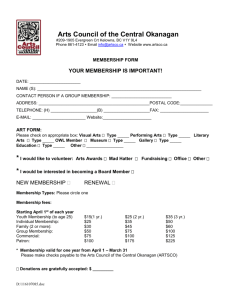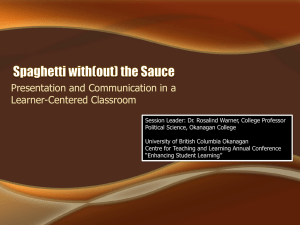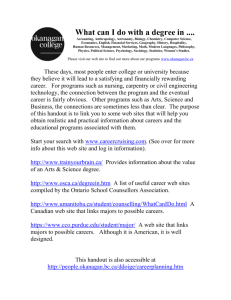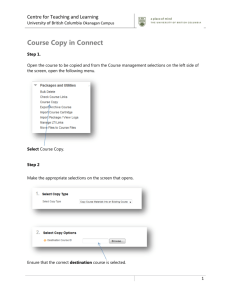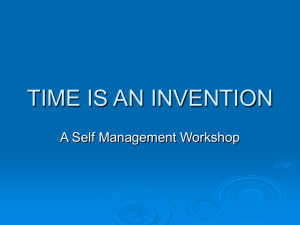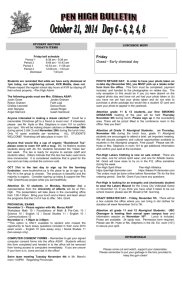Syilx Perspective on the Columbia River Treaty
advertisement
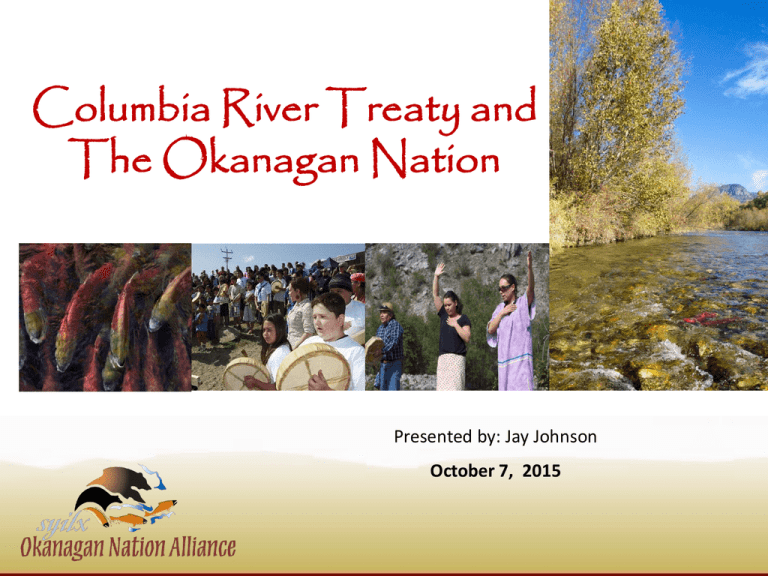
Columbia River Treaty and The Okanagan Nation Presented by: Jay Johnson October 7, 2015 Who are the Okanagan People? Okanagan (Syilx) Nation Revitalization of an Okanagan Fishery & the Salmon People Seven member band communities: 1. Osoyoos Indian Band 2. Penticton Indian Band 3. Westbank First Nation 4. Okanagan Indian Band 5. Upper Nicola Band 6. Lower Similkameen Band 7. Upper Similkameen Band, and 8. Colville Confederated Tribes (USA) One Historic Nation: Okanagan Nation , Colville Confederated Tribes - Sinixt •Sinixts original inhabitants of the Arrow Lakes •Sinixts and Okanagans in US and Canada share Nsyilxcen Language /Culture •Late 19th C. Small pox , encroachment devastated Sinixts populations •By 1960s Sinixts population abandoned last West Kootenay reserves • 2010 ONA reunified politically with CCT as both share ancestry/ history •First Nations still use and access region – regularly practice rights • Up to 8,000 Sinixts descendents reside primarily at CCT and the ONA Columbia River as a Life Force • Okanagan Nation People are a Salmon People • Columbia River is the main artery of the nation delivering salmon and as historical corridor • Okanagan System is a tributary • Industrialization and CRT devastated region & its Salmon • First Nations had no past involvement in CRT • Massive ecological and cultural impacts from CRT flooded lands/ fisheries and erosion Okanagan Declaration “The Okanagan Nation Declaration provides a shared vision for all activities within Syilx Territory and will be respected by all Member Bands and the ONA in carrying out their responsibilities under this Protocol.” Okanagan Title and Rights • Okanagan Nation has not surrendered its Title and Rights interests on its (69,000km2) Territory • The CEC is the elected political decision making collective body - all Chiefs • ONA is the administrative and technical arm of the Nation • ONA has five departments and nearly 75 staff • Strongest inland Fisheries dept. in Canada Game Changer–Supreme Court Tsilhqot’in Decision • Aboriginal Title is real and meaningful and can exist over large tracts of land (territories); • Aboriginal Title includes the vesting of full and beneficial economic interest in the land to the Aboriginal group; • Where Aboriginal Title exists, consent of the Collective Aboriginal group is required for the Crown or industry to use that land; and failing consent, the Crown has to meet the test of justifiable infringement; and • If the Crown authorizes activities on land which are demonstrated to be Aboriginal Title land, projects and permits may be cancelled, and damages owed to the Aboriginal group. Columbia River Treaty (CRT) • Water storage and management agreement btw US- Canada signed in 1961 and ratified in 1964 – • Flooded over 40,000 acres of prime valley bottom lands to store the 15.5 million Acre feet of water • No end date but after 60 years can terminate but requires 10 years notice • Created three new storage dams in Canada (Mica, Hugh Keenleyside and Duncan dams) • Sought to optimize flows for flood control and maximize power generation • Required coordinated efforts to manage water flows in the Columbia and Kootenay River systems CRT Impacts • CRT has had massive impact to First Nations the Title and Rights interests • Flooded thousands of acres of critical land – inundated village and burial sites, destroyed fishing and hunting grounds, fertile valley bottoms and many sacred sites • Altered the river system into an industrial managed reservoir • Continues to Impact on eco-systems and fisheries – erosion, dust, invasive species and ancestral remains Recent History – Salmon • Commercial Salmon Fisheries U.S. (1870’s) • Historical decisions did not consider First Nations or the importance of the Okanagan to fisheries – Main stem Columbia River Dams (1933) – Grand Coulee Dam blocks Salmon access to Upper Columbia (1938) with Canadian tacit support – Columbia River Treaty (1961-4) – Okanagan River Channelization and salmon Access in Okanagan River restricted (McIntyre Dam -1915) Background: Okanagan Sockeye • Okanagan sockeye population is one of three remaining Columbia River stocks • Mid 90’s less than 3,000; by 2014 via restoration returns over 400,000 • Okanagan run now makes up 70-90% of all Columbia river sockeye ARROW LAKES Okanagan Wenatchee Columbia River sub-basins historically accessible to sockeye Columbia River sub-basins with present day viable sockeye populations 1200 km and 9 major dams to get to spawning grounds on Okanagan River Okanagan River in 1938 and 1996 Habitat and Fish Passage: ORRI Phase 1 Before After DYKE SETBACK SPAWNING PLATFORM GRAVEL BARS RIFFLE REMEANDERING © One Wild Earth © Kevin Dunn How are the sockeye run doing? 300,000 Escapement estimate 250,000 200,000 150,000 Reference period trend in Okanagan River sockeye salmon Many Factors: • Stock augmentation • Fish water mgmt tools • Fisheries management (ocean and Columbia River) • Ceremonies • Habitat Restoration… Wells AUCriver Experiment Begins 350,000 100,000 50,000 0 1967196919711973197519771979198119831985198719891991199319951997199920012003200520072009 Return Year Starting to see benefits-economic and recreational fisheries Summary of Salmon Program Results • Results from monitoring impacts of sockeye reintroduction are promising so far • Relatively good juvenile abundance, growth, and survival • Low impact to native fish (such as kokanee) • Increased understanding that Mysis shrimp are driving the foodwebs • Increased Okanagan River sockeye but some smaller runs in the near future – Vulnerable (esp. Climate) • Results encouraging for Upper Columbia restoration CRT Review Process - ONA • • • • • ONA rejected BC’s original consultation process Insisted Canada Join review process Jointly designed new ‘Critical Path Process’ Led to deeper mutual understandings Created key negotiations venues but largely unsuccessful in creating resolution to date • Okanagan Nation interests line up with both BC and US on different issues • Chiefs remain committed to collaboration with local, Provincial and Federal Governments Related Policy Issues issues • Columbia WUP-water license/Fisheries Act authorizations do not consider downstream impacts – i.e. Salmon • Uncertainty over FNs/ Federal/Provincial jurisdictional roles • CRT must consider Salmon impacts as it is the way to influence US decisions • There will be years where structured flows won’t benefit Canadian salmon – vulnerable to flows • Improve annual fish survival measurements from the upper Columbia, including sockeye – We need a Canada salmon plan of studies funded – ONA/DFO in feasibility stage of year 1 for downstream survival studies Next Steps • • • • • Process to reconcile downstream impacts More Trans-boundary collaboration (ONA/DFO/CCT/FNs) More meaningful participation by Canada in ONA/CRT Deep Inclusion of ONA into Treaty Negotiations Process Continue water management and fish survival modeling with BC and Canada. • Mirror Mitigation process similar to U.S. process – Mitigate “uncontrollable losses” – Minimum standard (e.g. dry water years) + 0.5 MAF of Can flows? – Bigger investments in fish and eco-system restoration – Pursue Fish (Salmon) Passage studies and outcomes Okanagan Nation CRT Needs • Continue studies, modelling and community feedback • Eco-system Function as equal part of the treaty • Continue Bi-lateral Negotiations and involvement • Joint decision making • Revenue-sharing • Salmon Passage • Better Mitigation efforts Lim Limp’t (Thank You)
